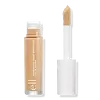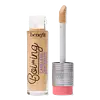What's inside
What's inside
 Key Ingredients
Key Ingredients

 Benefits
Benefits

 Concerns
Concerns

 Ingredients Side-by-side
Ingredients Side-by-side

Water
Skin ConditioningCyclopentasiloxane
EmollientPropylene Glycol
HumectantButylene Glycol Dicaprylate/Dicaprate
EmollientTrimethylsiloxysilicate
EmollientPolyglyceryl-4 Diisostearate/Polyhydroxystearate/Sebacate
EmulsifyingEthylhexyl Hydroxystearate
EmollientCetyl PEG/PPG-10/1 Dimethicone
EmulsifyingPropylene Glycol Dibenzoate
Skin ConditioningPEG-10 Dimethicone
Skin ConditioningDisteardimonium Hectorite
StabilisingSodium Chloride
MaskingPhenoxyethanol
PreservativeDimethicone
EmollientAcrylates/Polytrimethylsiloxymethacrylate Copolymer
Skin ConditioningDimethicone/Vinyl Dimethicone Crosspolymer
Skin ConditioningPerfluorooctyl Triethoxysilane
Trihydroxystearin
Skin ConditioningSilica
AbrasiveCaprylyl Glycol
EmollientEthylhexylglycerin
Skin ConditioningDisodium EDTA
Sodium Hyaluronate
HumectantRosa Damascena Flower Water
MaskingCI 77891
Cosmetic ColorantIron Oxides
Water, Cyclopentasiloxane, Propylene Glycol, Butylene Glycol Dicaprylate/Dicaprate, Trimethylsiloxysilicate, Polyglyceryl-4 Diisostearate/Polyhydroxystearate/Sebacate, Ethylhexyl Hydroxystearate, Cetyl PEG/PPG-10/1 Dimethicone, Propylene Glycol Dibenzoate, PEG-10 Dimethicone, Disteardimonium Hectorite, Sodium Chloride, Phenoxyethanol, Dimethicone, Acrylates/Polytrimethylsiloxymethacrylate Copolymer, Dimethicone/Vinyl Dimethicone Crosspolymer, Perfluorooctyl Triethoxysilane, Trihydroxystearin, Silica, Caprylyl Glycol, Ethylhexylglycerin, Disodium EDTA, Sodium Hyaluronate, Rosa Damascena Flower Water, CI 77891, Iron Oxides
Water
Skin ConditioningCyclopentasiloxane
EmollientButylene Glycol
HumectantCyclohexasiloxane
EmollientMethyl Methacrylate Crosspolymer
PEG-10 Dimethicone
Skin ConditioningTrimethylsiloxysilicate
EmollientCetyl PEG/PPG-10/1 Dimethicone
EmulsifyingSodium Chloride
MaskingDisteardimonium Hectorite
StabilisingTriethoxycaprylylsilane
Phenoxyethanol
PreservativeCaprylyl Glycol
EmollientDimethicone/Vinyl Dimethicone Crosspolymer
Skin ConditioningPropylene Carbonate
SolventBiosaccharide Gum-4
Skin ConditioningAlumina
AbrasiveMagnesium Oxide
AbsorbentAlpha-Glucan Oligosaccharide
CleansingPropanediol
SolventAlgin
MaskingPentaerythrityl Tetra-Di-T-Butyl Hydroxyhydrocinnamate
AntioxidantCI 19140
Cosmetic ColorantCI 42090
Cosmetic ColorantCI 77007
Cosmetic ColorantCI 77163
Cosmetic ColorantCI 77491
Cosmetic ColorantCI 77492
Cosmetic ColorantCI 77499
Cosmetic ColorantCI 77891
Cosmetic ColorantWater, Cyclopentasiloxane, Butylene Glycol, Cyclohexasiloxane, Methyl Methacrylate Crosspolymer, PEG-10 Dimethicone, Trimethylsiloxysilicate, Cetyl PEG/PPG-10/1 Dimethicone, Sodium Chloride, Disteardimonium Hectorite, Triethoxycaprylylsilane, Phenoxyethanol, Caprylyl Glycol, Dimethicone/Vinyl Dimethicone Crosspolymer, Propylene Carbonate, Biosaccharide Gum-4, Alumina, Magnesium Oxide, Alpha-Glucan Oligosaccharide, Propanediol, Algin, Pentaerythrityl Tetra-Di-T-Butyl Hydroxyhydrocinnamate, CI 19140, CI 42090, CI 77007, CI 77163, CI 77491, CI 77492, CI 77499, CI 77891
 Reviews
Reviews

Ingredients Explained
These ingredients are found in both products.
Ingredients higher up in an ingredient list are typically present in a larger amount.
Caprylyl Glycol is a humectant and emollient, meaning it attracts and preserves moisture.
It is a common ingredient in many products, especially those designed to hydrate skin. The primary benefits are retaining moisture, skin softening, and promoting a healthy skin barrier.
Though Caprylyl Glycol is an alcohol derived from fatty acids, it is not the kind that can dry out skin.
This ingredient is also used as a preservative to extend the life of products. It has slight antimicrobial properties.
Learn more about Caprylyl GlycolThis ingredient is a high molecular weight silicone. It has emulsifying and skin conditioning properties.
Ci 77891 is a white pigment from Titanium dioxide. It is naturally found in minerals such as rutile and ilmenite.
It's main function is to add a white color to cosmetics. It can also be mixed with other colors to create different shades.
Ci 77891 is commonly found in sunscreens due to its ability to block UV rays.
Learn more about CI 77891Cyclopentasiloxane, or D5, is a silicone used to improve texture of products and trap moisture.
D5 is considered lightweight and volatile. Volatile means it evaporates quickly after application. Once evaporated, D5 leaves a thin barrier that helps keep skin hydrated.
It is also an emollient. Emollients help soften the skin and prevent water loss. Silicones create a silky texture in products. D5 helps other ingredients become more spreadable.
Studies show D5 is safe to use in skincare products. We recommend speaking with a skincare professional if you have concerns.
Learn more about CyclopentasiloxaneThis ingredient is a silicone used to improve the texture of products and absorb oil. It does not get absorbed into the skin.
Like other silicones, Dimethicone/Vinyl Dimethicone Crosspolymer helps condition the skin by creating a barrier. In this sense, it can act as an emollient and trap moisture in.
This ingredient is a type of elastomer.
Learn more about Dimethicone/Vinyl Dimethicone CrosspolymerDisteardimonium Hectorite comes from the clay mineral named hectorite. It is used to add thickness to a product.
It can also help stabilize a product by helping to disperse other ingredients.
Hectorite is a rare, white clay mineral.
Learn more about Disteardimonium HectoritePeg-10 Dimethicone is silicone with conditioner and emulsifier properties. It mostly acts as an emollient in skincare and and humectant in haircare.
According to the manufacturer, acidic formulations decrease the stability of this ingredient. It works best in neutral or near neutral formulations.
Phenoxyethanol is a preservative that has germicide, antimicrobial, and aromatic properties. Studies show that phenoxyethanol can prevent microbial growth. By itself, it has a scent that is similar to that of a rose.
It's often used in formulations along with Caprylyl Glycol to preserve the shelf life of products.
Chances are, you eat sodium chloride every day. Sodium Chloride is also known as table salt.
This ingredient has many purposes in skincare: thickener, emulsifier, and exfoliator.
You'll most likely find this ingredient in cleansers where it is used to create a gel-like texture. As an emulsifier, it also prevents ingredients from separating.
There is much debate on whether this ingredient is comedogenic. The short answer - comedogenic ratings don't tell the whole story. Learn more about comegodenic ratings here.
The concensus about this ingredient causing acne seems to be divided. Research is needed to understand if this ingredient does cause acne.
Scrubs may use salt as the primary exfoliating ingredient.
Learn more about Sodium ChlorideThis silicone is an emollient. Emollients create a thin film on the skin to prevent moisture from escaping.
It is not soluble in water and helps increase water-resistance in products.
According to a manufacturer, it can blend seamlessly with silicone oils, such as Cyclopentasiloxane.
Learn more about TrimethylsiloxysilicateWater. It's the most common cosmetic ingredient of all. You'll usually see it at the top of ingredient lists, meaning that it makes up the largest part of the product.
So why is it so popular? Water most often acts as a solvent - this means that it helps dissolve other ingredients into the formulation.
You'll also recognize water as that liquid we all need to stay alive. If you see this, drink a glass of water. Stay hydrated!
Learn more about Water